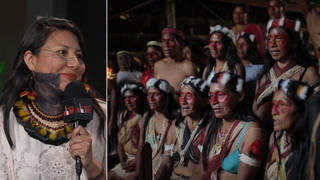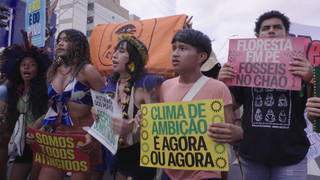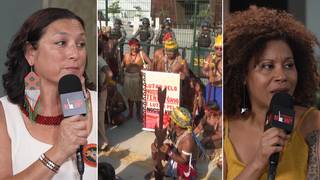
Guests
- Jesus Garciastatistician and demographer for La Raza Database Research Project.
- Ivette Xochiyotl Boyzomanager of La Raza Database Research Project.
The newly released Raza Database Project reveals the number of Brown and Black people killed by police in the United States may be more than double the amount that is widely reported. Statistician and demographer Jesus Garcia explains how the team merged data sets from independent research projects on police violence to more accurately determine the ethnicities of victims. These are “terrible numbers to look at,” says Garcia. “The results are stark and bare.” Project manager Ivette Xochiyotl Boyzo calls the research “groundbreaking” because of the lack of federal data collection on police violence. “It’s so unfortunate that there’s not any type of actual collection of information against these types of violences,” says Boyzo, who calls for accountability. “What’s the most disturbing out of all of this, it’s the impunity rate.”
Transcript
AMY GOODMAN: This is Democracy Now!, democracynow.org. I’m Amy Goodman, with Juan González, as we turn to a shocking new report that estimates 35,000 people have been killed by law enforcement in the U.S. since the year 2000 and that the number of Brown and Black people killed by police may be more than double the amount widely reported.
La Raza Database Project was founded by the late Roberto Rodríguez, also known as “Dr. Cintli,” who died in July. Rodríguez was associate professor of Mexican American studies at the University of Arizona, who himself survived a brutal police assault in 1979 when Los Angeles sheriff deputies beat him for taking pictures of them beating another man. He spent the rest of his life fighting police brutality and writing about Chicano culture. In 2021, he joined Democracy Now! to discuss how preliminary findings of the Raza Database Project’s report showed deaths of Latinx and Indigenous people at the hands of police were undercounted by a quarter to one-third in national databases and were virtually ignored by the media.
ROBERTO RODRÍGUEZ: One of the things that we asked ourselves as a group: Should we count all deaths, in custody, etc.? And everybody said yes. And personally, I wanted just the ones that are unjustified. But how do you determine what’s unjustified, when you don’t have a judicial system that works? You know, it’s like, I would say, 99.9% impunity both in the killings that we examined and also the Border Patrol. You know, you can count in one hand, with a finger or two to spare, of police officers that are doing hard time, say, 30, 40, 50 years to life. You know, I doubt there’s even five. Personally, I think that’s the actual solution. Until you see that, you’re not going to see anything. No reform is going to fix anything, because all a cop has to say is “I feared for my life.” You know? And that absolves everything.
AMY GOODMAN: The late professor Roberto “Cintli” Rodríguez, fondly referred to as “Dr. Cintli.”
For more on the formal release of La Raza Database Project, we’re joined by its project manager, Ivette Xochiyotl Boyzo, a mental health patient and civil and human rights advocate, and Jesus Garcia, demographer statistician on the project.
We welcome you both to Democracy Now! Jesus, let’s begin with you. Explain what you found.
JESUS GARCIA: Yes, Amy, Juan. Thank you very much for this opportunity to be here with you.
So, Roberto asked me to participate in this project on a volunteer basis. And he, more or less, as you heard, knew what the subject matter was, but he wasn’t able to articulate the statistics. And so, over the past two years, I’ve been looking at data from open-source information.
And what the results are, that the Latino population of people killed, Spanish surname, is at about 6,500 between the year 2000 and 2022. That’s an over 2000 increase from what some estimates say at about 4,500. Equally important here is the Asian population count. The Asian population count has gone from just about under 500 under old methodologies to over 2,000 deaths, a 75% increase. So, our goal with this project was to not only address the missing information for Latinos, but overall as to the impact on all our communities of color, all our disenfranchised people.
And to tell you the truth, this has been a very difficult project to work on personally. This is not my forte, but Roberto asked me to participate in this project. And I think the results are pretty groundbreaking, and they’re the beginning, not the end, of further discussions on this issue.
JUAN GONZÁLEZ: And, Jesus Garcia, I wanted to ask you, in terms of the increases in numbers, could you talk about what were the weaknesses of the previous counts, such as, for instance, The Washington Post’s big study that they did about police deaths? You found that there were a significant number of people who were listed as with no racial identity initially or as other, and that you were able to track down more clearly their ethnic or racial origin. Talk about that process.
JESUS GARCIA: Yes, absolutely. So, first of all, there is no federal standard for collection of this information. There’s no federal department at the Department of Justice or Center for Disease Control or the like. So the task of collecting data, as it is, has fallen on these open sources, and, in fact, on individuals. So, I’m talking about Fatal Encounters’ website, Mapping Police Violence. And, obviously, you’ve mentioned The Washington Post and The Guardian and others. But in the collection of this information, it’s compiled by, basically, independent people. And I think this is a very good reason for having good, independent media. Without a federal collection, independent media, independent sources are the ones that have compiled a list. So, when you’re doing these sorts of crowdsources of information, there’s going to be gaps. And a big gap are things like the race and ethnicity of an individual. In many cases, there are no names, the location. And so, there’s a host of issues with the data.
And so, what I was able to do was to merge these different data sets into one. And then, having worked at the U.S. Census Bureau and because of my background, I was able to then try to assign missing race and Hispanic — race and ethnicity, based on the U.S. Census Bureau’s 160,000 surname list. And so, as I mentioned, it’s taken two years to get to this point, but it’s because of independent sources. I also need to thank the Cal State University and the technology tools. These things are not easy to do. It takes specialized skills. And we just have been able to assemble a team of people and technologies to get us to this point.
So, the data, I feel, are fairly accurate. As I mentioned, there’s much more to do, but I stand by the counts that we have. And so, again, they’re terrible, terrible numbers to look at, but I think, like anything else, it’s a beginning of hopefully the healing of this very difficult time in our country here.
AMY GOODMAN: I wanted to bring —
JUAN GONZÁLEZ: And in terms — yeah, I just wanted to ask: Jesus Garcia, you also found a significant increase in the number of whites killed by police, didn’t you, in your study?
JESUS GARCIA: Yes. The initial data of over 33,000 deaths included over 9,000 unknown or other. And so, again — and included in that count was white ethnicity at about 11,300. Over the course of the new results, I was able to supplement that count by nearly 5,000 individuals. So the current count of people classified as white non-Hispanic is over 16,000 people. They comprise 50% of the deaths.
One thing that I have to note among the African American population is African Americans in the population represent about 12% of the U.S. population; they are, however, 24% or a quarter of all deaths. So, no matter what you may think out there politically, the data are clear that there is something happening that is greatly impacting our African American community. And, you know, the results are stark and bare. So, yes, the white count did increase, but so did all the other counts for race, ethnicity.
AMY GOODMAN: I wanted to bring Xochiyotl into this conversation, Ivette Boyzo, the project manager for La Raza Database Project. Two things, it’s Hispanic Heritage Month, and the significance of Roberto Rodríguez and all of his work — so sorry that we weren’t also speaking to him today, since he was going to bring us the final report, but we lost him in the last years. His significance, his imprint on this, but also, in particular, Ivette Boyzo, if you could talk about the sexual violence against particularly migrant women?
IVETTE XOCHIYOTL BOYZO: Good morning. Thank you so much for having me.
Absolutely, I think the report itself, the research that we’ve done, is groundbreaking. It’s revolutionary in itself. Unfortunately, it’s only given police brutality that we can actually prove and one of the only types of violences that we have data for. We don’t have a national account or any type of data when it comes to the violence against women, and especially when it comes to migrants, which is even more alarming, because, as you know, there’s forced sterilizations within the detention centers, women that have been forcefully sterilized as part of their probation terms in this country. So, when we look at the people being affected mostly by these type of genocidal practices, it’s women of color. So, if you ask me, under international law, these are crimes against humanity. This is a genocide. And it’s so unfortunate that there’s not any type of actual collection of information against these types of violences and crimes against humanity.
JUAN GONZÁLEZ: And could you — what was most surprising to you as you were compiling the data and getting a final report?
IVETTE XOCHIYOTL BOYZO: I think, unfortunately, there was not much of a surprise. I think, within our communities, the Indigenous community, the migrant community, the undocumented community, any community of color, this is just a mere reflection of the truth that we have known for a long time. We know that violence has existed from the conception of this country, and it just continues to evolve and take a different name and role.
I think what’s the most disturbing out of all of this, it’s the impunity rate and how the judicial system has been set in place to hold people accountable, and that people are supposed to be innocent until proven guilty, and yet we see people that have a weapon and a badge, and they determine who lives and dies, basically, under their discretion, with no proper training, with no adequate tools. And this is affecting thousands and thousands of people in the United States.
AMY GOODMAN: Xochiyotl, we have to end here, but we’re going to conduct this interview in Spanish, as well, and we’ll post it at democracynow.org. Ivette Boyzo, project manager for La Raza Database Project, and Jesus Garcia, demographer and statistician on the project. That does it for our show. I’m Amy Goodman, with Juan González. Thanks for joining us.












Media Options